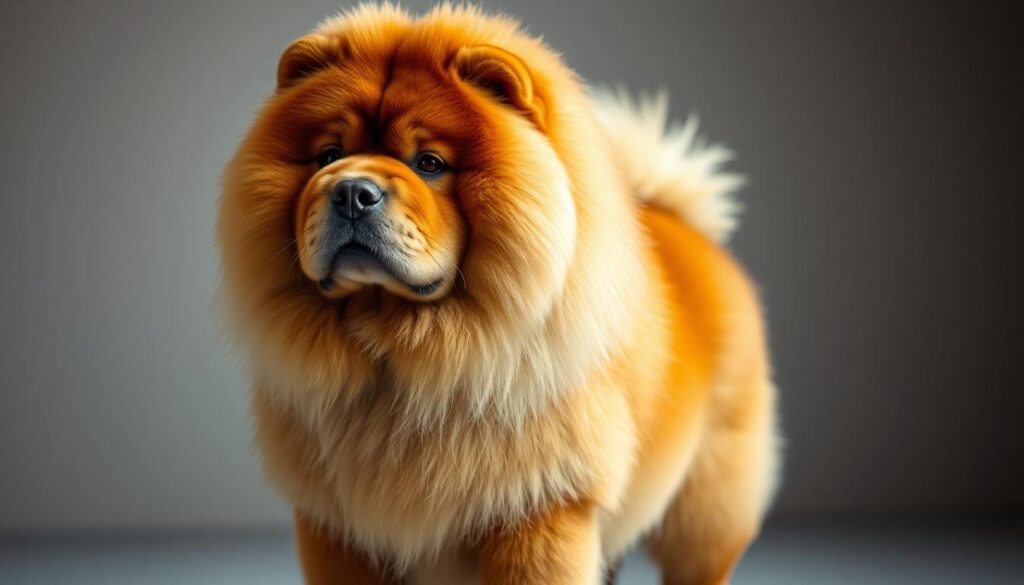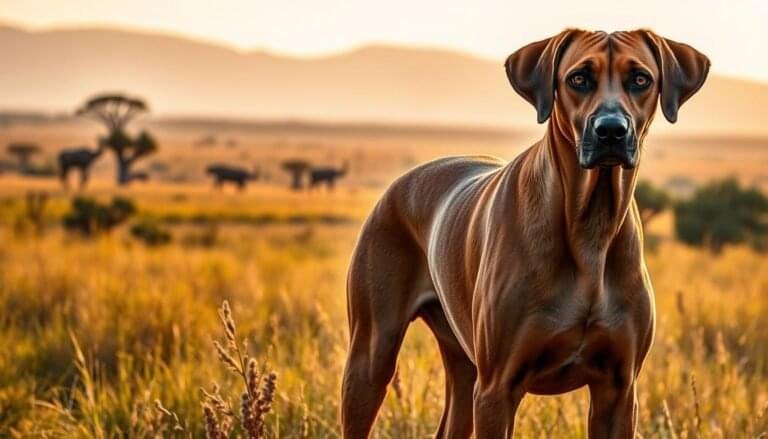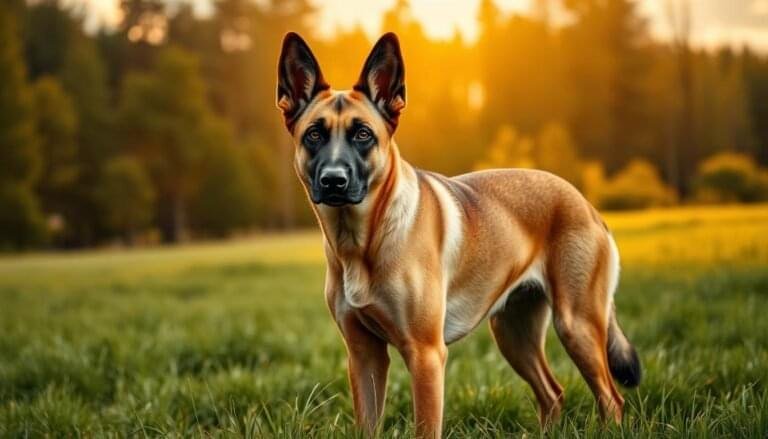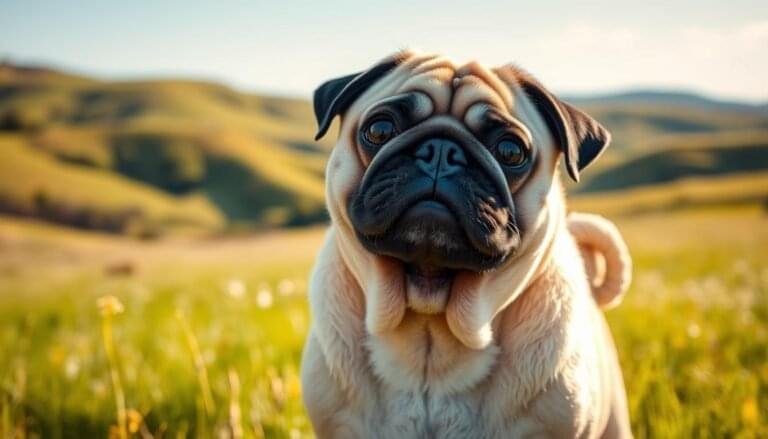Did you know Chow Chows have a blue-black tongue? This makes them unique in the dog world. They are known as the “lion dog” of China.
I’m excited to share with you the Chow Chow breed. These dogs are fascinating and ancient. They stand 17-22 inches tall and have a lion-like look.
Chow Chows come from China and have a long history. They’ve been hunters and cart-pullers. Now, they’re loved pets known for their loyalty and independence.
Chow Chows have a thick double coat in five colors: red, black, blue, cinnamon, and cream. They are beautiful but need regular grooming and exercise to stay healthy.
Exploring Chow Chows, you’ll learn about their unique traits and personalities. This guide will help you understand their care, health, and lifestyle needs. Whether you’re thinking of getting one or just curious, this guide is for you.
Key Takeaways
- Chow Chows have a unique blue-black tongue
- They originate from China and have a rich history
- The breed comes in five different coat colors
- Chow Chows require regular grooming and moderate exercise
- They are known for their independent and loyal nature
- Health considerations include hip dysplasia and eye issues
- Chow Chows have a lifespan of 9-15 years
Physical Characteristics of Chow Chows
Chow Chows are striking dogs with unique features. These traits make them stand out from other breeds. Let’s explore what makes them so captivating.
Size and Weight
Chow Chows are medium to large dogs. They stand 17 to 20 inches tall at the withers. Males weigh 55 to 70 pounds, while females weigh 45 to 55 pounds. Their sturdy build makes them look commanding.
Coat Colors
The Chow Chow’s fluffy coat comes in five colors: red, black, blue, cinnamon, and cream. Red and black are the most common. Their coat can be rough or smooth, with rough being more common.
Eyes and Ears
Chow Chows have almond-shaped eyes that make their face expressive. Their small, triangular ears stand erect, showing they’re alert. As a flat-faced breed, their features are compacted, giving them a unique look.
Unique Features
The most notable feature of Chow Chows is their blue-black tongue. This trait is rare in dog breeds. It develops when they’re 8 to 10 weeks old. Their thick double coat and lion-like mane around the neck are also unique.
| Feature | Description |
|---|---|
| Coat Type | Rough or Smooth |
| Colors | Red, Black, Blue, Cinnamon, Cream |
| Tongue Color | Blue-Black |
| Eyes | Almond-shaped |
| Ears | Small, Triangular, Erect |
Chow Chow Temperament
The Chow Chow’s temperament is as unique as its lion-like appearance. This ancient breed, with roots tracing back over 2,000 years, has a complex personality. It makes them stand out among companion dogs.
Loyalty
Chow Chows are renowned for their unwavering loyalty. A staggering 70% of owners report their Chows as fiercely protective of family members. This loyal guardian instinct makes them excellent watchdogs, always alert and ready to defend their loved ones.
Independence
The breed’s independent nature stems from its history as a working dog. About 35% of Chows exhibit stubbornness, which can pose challenges during training. Their bold independence requires short, consistent daily training sessions for best results.
Socialization
Early socialization is key for Chow Chows. It’s recommended to start immediately upon bringing one home, regardless of age. Without proper socialization, approximately 20% of Chows may show aggressive behavior. A study found that 55% of well-socialized Chows are described as calm and reserved in unfamiliar situations.
Aggression
Contrary to misconceptions, aggression in Chow Chows is not innate but often results from lack of socialization. About 30% of Chows tend to be overly territorial. With proper training and socialization, these loyal companions can become dignified and devoted family members, showing their true nature as protective yet gentle guardians.
Health Considerations for Chow Chows
Chow Chows have a bear-like look and face some health issues. We’ll look at these problems, their lifespan, and why regular vet visits are key.
Common Health Issues
Chow Chows often deal with hip and elbow dysplasia. This can make walking hard and might cause arthritis. They also get eye problems like cataracts and entropion. Plus, diabetes is more common in them, mainly in older or heavier dogs.
Lifespan
Chow Chows usually live 8 to 12 years. Their life span depends on their genes, diet, exercise, and health care.
Regular Veterinary Care
It’s important to take Chow Chows to the vet regularly. These visits help catch health issues early and keep them healthy. They need vaccinations, dental care, and help with weight management.
Preventive Health
Preventing health problems can greatly improve a Chow Chow’s life. Keeping them at a healthy weight is key. Regular grooming helps avoid skin problems. Also, socializing them early is important for their mind and behavior.
| Health Issue | Prevalence | Prevention/Management |
|---|---|---|
| Hip Dysplasia | Common | Weight management, joint supplements |
| Eye Problems | High | Regular eye exams, prompt treatment |
| Diabetes | Higher than average | Proper diet, regular exercise |
| Allergies | Common | Identify triggers, appropriate treatment |
Chow Chow Training Methods
Training a Chow Chow needs patience and special techniques. They are independent and need early training. This helps them learn good habits and avoid bad behavior.
Basic Commands
I start training Chow Chows when they are 8 to 10 weeks old. Short training sessions of 5 to 10 minutes keep them interested. Using treats and praise helps teach them basic commands like sit, stay, and come.
Advanced Training
Advanced training focuses on using their guarding instincts. Training them to patrol and long-leash recall helps. Crate training also provides security and helps with house training.
Socialization Strategies
Early socialization is key for Chow Chows. I introduce them to different people, animals, and places. This helps prevent fear and aggression. I also start grooming early to make handling positive.
Dealing with Stubbornness
Chow Chows can be stubborn, but staying consistent is important. I keep a daily routine with set times for feeding, walks, and training. If problems come up, getting help from a professional dog trainer can be helpful.
| Training Aspect | Recommendation |
|---|---|
| Session Duration | 5-10 minutes |
| Starting Age | 8-10 weeks |
| Training Method | Positive reinforcement |
| Diet for Focus | Protein-rich, real meat |
Exercise Requirements for Chow Chows
Chow Chows are known as loyal guardians. They have special exercise needs. I’ll show you how to keep your furry friend healthy and happy.
Daily Walks
Chow Chows need 30 to 60 minutes of walks each day. As a loyal guardian, they need at least one walk a day. Try to walk at a pace of 2-3 miles per hour.
Remember, these dogs don’t like the heat. So, avoid walks during the hottest times of the day.
Playtime Activities
Break exercise into shorter sessions to match your Chow’s independent nature. Swimming is a great activity if you start early. Some Chow Chows might need life jackets because they float well.
Always watch them when they’re in the water for safety.
Mental Stimulation Games
Keep your loyal guardian busy with puzzle toys and games. These activities prevent boredom and keep their minds sharp. Try new walking routes to challenge their problem-solving skills.
Recommended Exercise Routines
Adjust exercise based on your Chow’s age and health. Older Chow Chows might need shorter, easier walks. Avoid activities that could hurt their joints.
Signs they’re getting enough exercise include staying at a healthy weight and being calm at home. Regular vet visits help tailor exercise plans to their needs.
Remember, your Chow Chow is a loyal guardian who loves moderate exercise and mental games. Follow these tips to keep your furry friend happy and healthy for many years.
Grooming Essential for Chow Chows
Chow Chows have a fluffy coat that needs regular grooming. This keeps them healthy and looking great. Here are some key tips to help your Chow look their best.
Brushing Frequency
Brush your Chow Chow 2-3 times a week. In spring and fall, when they shed a lot, brush them every day. Use a slicker brush and pin brush to handle their thick double coat well.
Brushing regularly stops mats from forming. This is important behind the ears, under the legs, and around the collar.
Bathing Guidelines
Bathe your Chow every 6-8 weeks, or once a month in shedding seasons. Use dog-specific shampoos to keep their skin and coat healthy. Make sure to rinse them well to avoid skin irritation.
Getting a professional groom every 6-8 weeks helps keep their coat in top shape. It also helps manage mats.
Nail Clipping
Trim your Chow’s nails every 2-3 weeks, based on how fast they grow. If you’re not sure how to do this, get professional help. Keeping their nails short prevents pain and foot problems.
Ear Cleaning
Clean your Chow’s ears weekly to avoid infections. Use a gentle, dog-safe ear cleaner and cotton balls. Don’t put anything into their ear canal.
If you see redness or a bad smell, talk to your vet right away.
Grooming is more than just making your Chow look good. It’s a way to bond with them and check for any skin problems. With regular grooming, your Chow’s fluffy coat will stay healthy and beautiful.
Living Environment for Chow Chows
Creating the perfect home for your Chow Chow is key. These pets can live in many places, but they need certain things to be happy.
Ideal Home Setup
Chow Chows fit well in big houses or small apartments. What’s important is a comfy spot with the right temperature. Keep your home between 60-75°F (15-24°C) for their comfort. In summer, air conditioning is essential to avoid heatstroke.
Compatibility with Leash Training
Leash training is important for Chow Chows, more so in cities. They need regular walks, about four times a day. This keeps them healthy and mentally sharp.
Outdoor Space Needs
Chow Chows don’t need big yards but love to go outside. A small, fenced area is perfect for play and potty breaks. They have thick coats and can get too hot, so avoid hot weather for walks.
Safe Indoor Environment
Inside, make a quiet, calm space for your Chow Chow. They prefer being alone and aren’t good with kids. Give them a cozy bed away from drafts and heat. Regular grooming is needed to handle their heavy shedding, which happens twice a year.
| Living Environment Factor | Chow Chow Preference |
|---|---|
| Temperature Range | 60-75°F (15-24°C) |
| Exercise Needs | 4+ casual walks daily |
| Home Type | Adaptable (house or apartment) |
| Outdoor Space | Small, fenced area sufficient |
| Household Composition | Single-dog home, quiet environment |
Nutrition Guide for Chow Chows
Feeding your Chow Chow, a beloved Chinese breed, needs careful thought. I’ll share tips on making a balanced diet for their unique needs.
Recommended Diet Types
Chow Chows do well on a diet full of vegetables, fish, poultry, and grains. These should be 80% of their protein. Only give them red meat like lamb or mutton. Stick to white meats, with animal protein not over 20% of their diet.
Portion Control
Chow Chows can easily gain weight. Adult dogs should eat twice a day. Puppies need 3-4 small meals for growth. Adjust their food based on their age, size, and how active they are. Regular exercise and controlled feeding help avoid obesity.
Treats and Snacks
Include treats in their daily food count. Omega-3 and Omega-6 fatty acids from fish or flaxseed oil improve their coat. But, avoid sugary snacks like carrots or beets, as they can cause diabetes or glaucoma.
Foods to Avoid
Stay away from high-carb foods, which can harm Chow Chows. Raw eggs might block biotin absorption. Too much protein can lead to kidney stones and joint problems. Always check labels, as some brands have fillers despite claiming to be healthy.
Proper nutrition is vital for your Chow Chow’s health. Talk to your vet for advice that fits your dog’s needs.
Common Misconceptions About Chow Chows

Chow Chows are often misunderstood. They are seen as loyal guardians. Let’s clear up some myths about these lion dogs.
Temperament Stereotypes
Many think Chow Chows are aggressive. But this is because they are shy around new people. Their behavior really depends on how they are raised and socialized. With the right training, they can be friendly and loving.
Grooming Myths
Some believe Chow Chows don’t need much grooming because of their fluffy look. But, their thick fur needs daily brushing. This keeps their coat from matting and controls their shedding.
Size and Space Needs
Chow Chows may look big, but they can live in different places. They don’t need a lot of room. What they do need is regular exercise to stay happy and healthy.
Social Behavior
Chow Chows are sometimes seen as unfriendly. But, they are really loyal to their families. They can be shy with new people. Early socialization helps them get along better with kids and other pets.
| Misconception | Reality |
|---|---|
| Aggressive by nature | Temperament influenced by training and socialization |
| Low grooming needs | Requires daily brushing to manage shedding |
| Needs large space | Adaptable to various living situations with proper exercise |
| Unfriendly to all | Reserved with strangers, loyal to family |
Knowing the truth about Chow Chows helps people decide if they’re right for them. With the right care and training, they can be amazing, loyal friends.
Adopting a Chow Chow
Getting a Chow Chow as a pet is an exciting adventure. I’ll help you through the adoption process. We’ll cover finding your new pet and getting them settled in.
Finding Reputable Breeders
Look for breeders with a good reputation. Lady Dunbar of Mochrum was a pioneer over 100 years ago. Today, breeders focus on health and temperament.
Rescue Organizations
Adopting from rescue groups is rewarding. Dogs like 3-year-old blue female Sasha are waiting for homes. Rescue dogs and retired show Chows are often cheaper than puppies.
Preparing for Adoption
Prepare well before your Chow arrives. If you have other dogs, introduce them slowly over 4 weeks. Neutering or spaying helps prevent fights. Learn about the dog’s past with other Chows and consider a trial period.
First Days at Home
Focus on building trust in the first days. Have one person feed the dog to create a bond. Check if your Chow is comfortable with touches. Start walks in familiar places once they trust you. Begin grooming where they feel most comfortable.
| Adoption Aspect | Timeframe | Notes |
|---|---|---|
| Socialization Period | 10 minutes | Time for Sasha to become social with guests |
| Initial Compatibility Assessment | 15 minutes | Time to evaluate new dog with Sasha |
| Gradual Introduction | 4 weeks minimum | Period for new dog to integrate with existing Chow |
| Trial Period | Varies | Recommended to ensure compatibility before adoption |
Traveling with a Chow Chow
I’m excited to share my insights on traveling with a Chow Chow. These dogs, known for their bear-like appearance, can be great travel buddies with the right prep. Let’s dive into some key points to ensure a smooth journey with your furry friend.
Travel Tips
When planning a trip with your Chow Chow, keep in mind their size and needs. These dogs typically stand 17 to 20 inches tall and weigh 45 to 70 pounds. For car travel, take breaks every few hours for exercise and bathroom stops. If flying, choose a USDA-approved crate that costs around $200. Remember, Chow Chows need extra time to get used to new situations due to their strong-willed nature.
Safety Precautions
Safety is key when traveling with your Chow Chow. Make sure your dog wears a collar with current ID tags and is microchipped. Pack a health kit with regular meds, flea and tick prevention, and vaccination records. Know where vets are along your route and at your destination. For air travel, avoid feeding your dog right before the flight to prevent stomach issues. Be aware that cargo holds can reach altitudes over 30,000 feet and aren’t always temperature-controlled.
Accommodation Considerations
When booking a place to stay, look for pet-friendly options that can handle a dog of the Chow Chow’s size. Bring familiar items like toys and blankets to help your dog feel at home. Remember, Chow Chows have thick double coats and can overheat easily. Make sure your accommodation has air conditioning for warm weather. In colder climates, pack extra bedding or a coat for outdoor activities.
Making Travel Comfortable
To keep your Chow Chow comfy during travel, pack their regular food and stick to their usual diet. Bring grooming tools like a good brush and dog shampoo. For long car rides, plan frequent breaks and short walks. If traveling to a warm place, pack cooling mats or vests. During flights, use warm moist heat on your dog’s ears before takeoff and landing to ease discomfort. With these tips, you and your Chow Chow can enjoy a great trip together!
FAQ
Are Chow Chows good family dogs?
How often should I groom my Chow Chow?
Are Chow Chows aggressive?
How much exercise does a Chow Chow need?
What health issues are common in Chow Chows?
Can Chow Chows live in apartments?
What’s special about a Chow Chow’s tongue?
Are Chow Chows easy to train?
How long do Chow Chows typically live?
Are Chow Chows good with other pets?
References
| Source Name | URL |
|---|---|
| Chow Chow – Wikipedia | https://en.wikipedia.org/wiki/Chow_Chow |
| American Kennel Club (AKC) | https://www.akc.org/dog-breeds/chow-chow/ |







